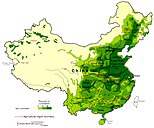Portal:Agriculture/Selected article/23
Agriculture is an important economic sector of China, employing over 300 million farmers. China ranks first in worldwide farm output, primarily producing rice, wheat, potatoes, sorghum, peanuts, tea, millet, barley, cotton, oilseed, pork, and fish. Following the Communist Party of China's victory in the Chinese Civil War, control of the farmlands was taken away from landlords and redistributed to the 300 million peasant farmers. In 1952, gradually consolidating its power following the civil war, the government began organizing the peasants into teams. Three years later, these teams were combined into producer cooperatives, enacting the Socialist goal of collective land ownership. In the following year, 1956, the government formally took control of the land, further structuring the farmland into large government-operated collective farms.
As China continues to industrialize, vast swaths of agricultural land is being converted into industrial land. Farmers displaced by such urban expansion often become migrant labor for factories, but other farmers feel disenfranchised and cheated by the encroachment of industry and the growing disparity between urban and rural wealth and income.
The most recent innovation in Chinese agriculture is a push into organic agriculture. This rapid embrace of organic farming simultaneously serves multiple purposes, including food safety, health benefits, export opportunities, and by providing price premiums for the produce of rural communities, the adoption of organics can help stem the migration of rural workers to the cities. In the mid 1990s China became a net importer of grain, since its unsustainable practices of groundwater mining has effectively removed considerable land from productive agricultural use. (Full article...)

